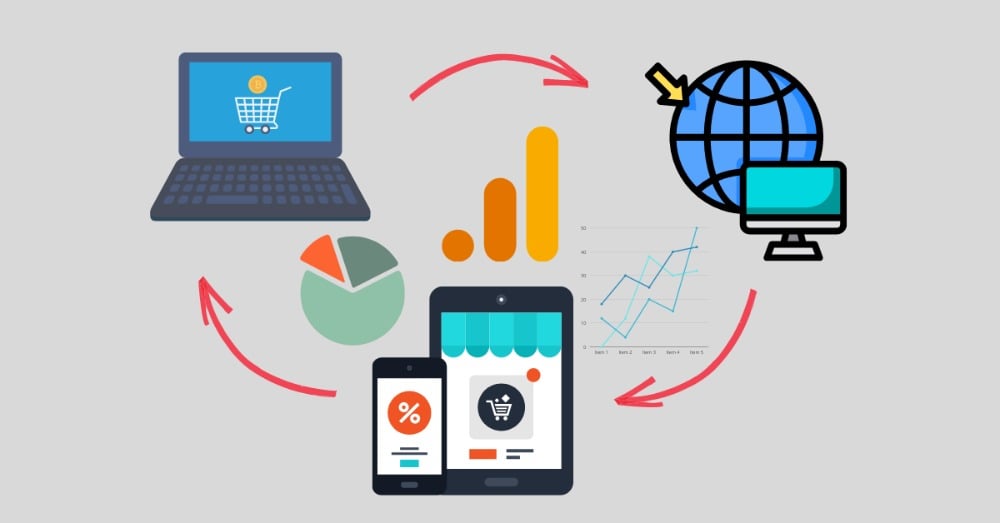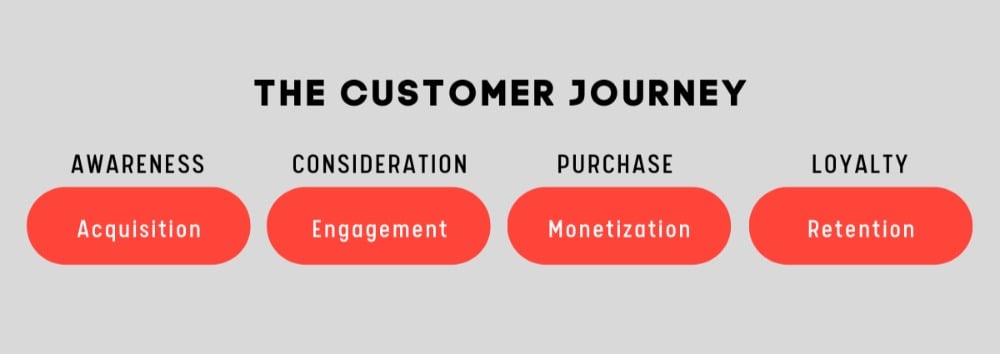Google Analytics 4 is the future. If you’re not yet comfortable with that, give us 5 minutes and we’ll change your mind.
In this article, you’ll know exactly what benefits you’re getting when you start using GA4 and why you should quit hesitating right now.
Here are 10 key benefits of GA4 that will future-proof your Analytics strategy.
1. BigQuery integration
BigQuery is a data warehouse that allows for the processing of SQL queries at very high speeds, thanks to Google’s powerful infrastructure. With the GA4 + BigQuery integration, you will have the means to analyze terabytes of raw data, take advantage of the insights brought about by the platform’s machine-learning capabilities, and even stream data directly to BigQuery (without the need to run a load job). Of course, these all translate to ways to leverage all the raw data you get your hands on.
Originally available only to GA360 (paying) users, BigQuery is now accessible through GA4 for free. Although there are quotas and limits on the data you can store and query via the free tier, there’s already so much you can do with the monthly free data allowance. You get 10GB of free storage and free processing of up to 1TB of query data.
2. Unsampled data
With Universal Analytics (UA), there’s a monthly limit of 10 million hits per property to the amount of data that can be collected. And a lot of sampling can occur when processing data—for example, when you apply an advanced segment and exceed 500,000 sessions.
Sampling has been removed in GA4 standard reports and data that can be collected is now unlimited. Having access to unsampled data is significant because it ensures that you are basing your decisions on reliable data. While sampling may be useful, as is done when working with segments and secondary dimensions, you run the risk of working with incomplete information if you depend on sampled data.
3. Extended segmentation possibilities
Audiences in GA4 allow for more targeted segments for marketing campaigns. You can now create segments based on events, which is not an option in UA, and add the concept of time if you wish.
So what this means is that you can now focus more on users and their interactions—no more unnecessary splitting by device or platform type. And by embedding the concept of time in your segment, you can do so much more, like analyzing the time users spent between steps in your sales funnel.
It’s also useful to note that any published audience will automatically be shared with Google Ads. The precise audience that you want to reach will be right there when you run a campaign.
4. Engagement metrics
Instead of giving you the bounce rate, or the percentage of users that leave a page without any interaction, GA4 gives you positive data on user engagement. A session is considered engaged when it lasts for at least 10 seconds, has at least one conversion event, or involves at least two page views.
Enhanced measurement events—such as scroll, site search, video engagement, and file downloads—let you know exactly how users are interacting with your site and content. These will all give you an idea on, for example, whether your blog post or eBook landing page is engaging enough for your audience to continue reading or sign up for a download. Enabling tracking like this in UA requires considerable custom coding.
5. Cross-platform tracking

Website and app engagement were always measured separately before GA4. You can imagine why Google Analytics 4 was called Google Analytics App+Web while still in beta.
GA4 now combines these two in one property: Firebase Analytics data from apps and Google Analytics data from websites. This means that having a complete view of engagement across your platforms no longer has to involve a manual and tedious process.
And this brings us to the next key benefit of GA4.
6. Complete user journey
There’s a new section in GA4 called Life Cycle, under which reports on Acquisition, Engagement, Monetization, and Retention can be found. If you noticed, these categories align with the customer journey.
It’s now easier than ever to zoom in on customer behavior and get insights on where marketers should direct more attention or change their strategy. The acquisition and engagement reports could tell you which of your awareness campaigns or paid ads, for example, are working and which types of content bring the most value to your users—or the reverse.
Of course, you also want to know how much of your revenue goals you are hitting and if you’re doing enough to build customer loyalty. The monetization and retention reports show data on revenue and how well you are keeping your customers.

GA4’s ability to stitch together the user journey comes from its user-centric analytics and event-driven data model. So if a user first visits your website on their desktop computer, then browses through your products on their smartphone, and eventually purchases through your app, GA4 gives you the tools to track all these events together and give you a holistic view of the customer journey. That’s one key benefit of GA4 that marketers can fully take advantage of.
7. More intelligent tracking
With new and stricter privacy laws being implemented by governments and regulatory organizations, it is becoming more and more difficult to track users using cookies. And we know that current tracking methods still heavily rely on cookies.
Yet Google assures us:
“Because the technology landscape continues to evolve, the new Analytics is designed to adapt to a future with or without cookies or identifiers. It uses a flexible approach to measurement, and in the future, will include modeling to fill in the gaps where the data may be incomplete. This means that you can rely on Google Analytics to help you measure your marketing results and meet customer needs now as you navigate the recovery and as you face uncertainty in the future.”
Vidhya Srinivasan, Vice President, Engineering, Google Ads, Google
Using AI and machine learning, GA4 implements more intelligent tracking that is not reliant on cookies.
8. Advanced analysis
Previously accessible only to GA360 users, a set of tools for carrying out advanced analysis and creating ad hoc funnels is now available for free in GA4.
- More elaborate funnel customization options allow you set up very specific funnels.
- Path analysis lets you identify the most common paths taken by users (e.g., from reading an article to signing up for the newsletter).
- Heat maps add a new dimension to your analysis.
- The segment overlap report shows you the relationships between the segments you are targeting.
- The user explorer report lets you get a closer look at particular user segments that you find most relevant to your analysis.
9. Predictive metrics
What would you do if you could predict which users are likely to buy within the next month and how much revenue will come from their purchase conversions?
Exactly. You nudge them to buy!
Three predictive metrics are introduced in GA4, allowing you to do just that:
- Purchase probability – the probability that a user who has been active in the last 28 days will make a purchase within the next 7 days
- Churn probability – the probability that a user who was active within the last 7 days will be inactive within the next 7 days
- Revenue prediction – the expected revenue within the next 28 days from a user who has been active in the past 28 days
You can use these metrics to create predictive audiences that you can then use to create highly targeted campaigns, and during critical periods in terms of conversion likelihood.
10. Better ROI
Now, because you have highly insightful analytics reports to work with, you can plan your campaigns better and target the relevant audience within the timeframe that matters.
If you play your cards right, you should be on your way to creating successful marketing campaigns that hit goals—leading to better ROI on ad spend.
And there you have the 10 key benefits of GA4 that you’re missing out on if you’re choosing to stay in your comfort zone.
While we’re not telling you to abandon your existing Universal Analytics property, you should definitely start with Google Analytics 4 now. GA4 is loaded with a lot of incredible new features that will future-proof your Analytics strategy.
But how much GA4 can do will depend on how much data it has to work with. And you should know that it takes time to accumulate sufficient data to make any substantial analysis possible. The sooner you start, the sooner you’ll get to collect essential data and become comfortable with the changes that GA4 brings with it.
Not confident you can pull off implementing GA4 yet? Our experts are happy to help you achieve your Analytics goals wherever you are in your journey. Get in touch with our Analytics team and get a digital analytics health check as a first step!



Share on: